Design and Testing of a 2-DOF Adaptive Profiling Header for Forage Harvesters
Abstract
:1. Introduction
- (1)
- An adaptive profiling header with 2-DOF adjustment is designed. This header achieves 2-DOF adjustment through the height adjustment mechanism and the tilt adjustment mechanism.
- (2)
- A relationship model between the profiling device and the header attitude is established. This model is the theoretical basis for the header attitude control strategy, which enables the system to detect terrain changes in real time.
- (3)
- A co-simulation model of ADAMS and MATLAB/Simulink was built, and the header attitude control system was designed based on the fuzzy PID algorithm. The co-simulation results verified the rationality of the mechanical design of the 2-DOF adjustment header, and the profiling mechanism can accurately reflect the undulating changes of the terrain.
- (4)
- A test platform was built and tested. The test results showed that the header can achieve adaptive adjustment of height and inclination, and the control system has high accuracy, stability, and reliability, which provides a reference for the design of the header attitude adaptive adjustment system of the forage harvester.
2. Materials and Methods
2.1. Design of 2-DOF Adjustment Mechanism for Header
2.1.1. Height Adjustment Mechanism
2.1.2. Tilt Angle Adjustment Mechanism
2.2. Structural Design of the Header
2.2.1. 3D Model of the Header
2.2.2. Relationship Model between Profiling Device and Header Attitude
2.3. Working Principle of Header Adaptive Adjustment
2.4. ADAMS and MATLAB/Simulink Co-Simulation Model
2.4.1. Virtual Road
2.4.2. Design of Fuzzy PID Controller
- (1)
- When the deviation is large, the response speed needs to be increased to eliminate the system deviation as soon as possible. At the same time, in order to avoid overshoot of the system response, the proportional coefficient should be increased, the differential coefficient should be reduced, and the integral coefficient is usually zero.
- (2)
- When the deviation and the deviation change rate are medium, needs to be reduced, and and take medium values to ensure the response speed of the system and reduce the overshoot of the system.
- (3)
- When the deviation is small, by increasing the values of and , the system has better steady-state performance. Considering the anti-interference ability of the system, in order to avoid overshoot and oscillation, should be appropriately selected.
- (4)
- When the deviation change rate is large, should be reduced and should be increased.
2.4.3. Co-Simulation Based on Fuzzy PID Control System
- Construction of Co-Simulation System
- b.
- Evaluation Metrics
- c.
- Co-Simulation Results and Analysis
3. Experimental Testing and Analysis
3.1. Test Platform Construction
3.2. Calibration of Header Profiling Device
3.3. Header Attitude Adjustment Test
4. Discussion
5. Conclusions
- (1)
- An adaptive profiling header with 2-DOF adjustment is designed. This study realizes 2-DOF adjustment of the header through height adjustment mechanism and tilt angle adjustment mechanism and installs the profiling device on both sides of the header by contact measurement. A relationship model between the profiling device and the header attitude is established so that the header can obtain the ground undulation in real time through the angle sensor of the profiling device.
- (2)
- A co-simulation model of ADAMS and MATLAB/Simulink was built and the header attitude control system was designed based on the fuzzy PID algorithm. The co-simulation results show that the mechanical design of the adaptive profiling header with 2-DOF adjustment designed in this study is reasonable, the profiling mechanism can accurately reflect the undulating changes of the terrain, and the accuracy of the header attitude control system meets the test indicators and has good robustness.
- (3)
- A test platform was built and tested. The results of the calibration test showed that the header profiling mechanism can accurately reflect the undulation of the terrain and verified the accuracy of the profiling device and the header attitude model. The grassland test results showed that the header can achieve adaptive adjustment of height and inclination, and the control system has high accuracy, stability, and reliability, which provides a reference for the design of the header attitude adaptive adjustment system of the forage harvester.
Author Contributions
Funding
Data Availability Statement
Acknowledgments
Conflicts of Interest
References
- Hamilton, S.A.; Kallenbach, R.L.; Bishop-Hurley, G.J.; Roberts, C.A. Stubble Height Management Changes the Productivity of Perennial Ryegrass and Tall Fescue Pastures. Agron. J. 2013, 105, 557–562. [Google Scholar] [CrossRef]
- Yang, Z.; Minggagud, H.; Baoyin, T.; Li, F.Y. Plant production decreases whereas nutrients concentration increases in response to the decrease of mowing stubble height. J. Environ. Manag. 2020, 253, 109745. [Google Scholar] [CrossRef] [PubMed]
- Liu, Q.; Li, C.; Wei, X.; Lu, Z.; Wang, A. Research on the header height control strategy of combine harvester based on LQR. J. Electron. Meas. Instrum. 2022, 36, 65–72. [Google Scholar] [CrossRef]
- Zhang, Z.; Chi, R.; Dong, N.; Du, Y.; Li, X.; Xie, B. Design and Testing of an Intelligent Control System for Maize Picking Harvest. Appl. Sci. 2020, 10, 8888. [Google Scholar] [CrossRef]
- Lopes, G.T.; Magalhães, P.S.G.; Nóbrega, E.G.O. AE–Automation and Engineering Technologies. Biosyst. Eng. 2002, 81, 261–272. [Google Scholar] [CrossRef]
- Xie, S.; Zhao, H.; Yang, S.; Xie, Q.; Yang, M. Design, Analysis and Test of Small Rotary Lawn Mower of Single-Disc Type. INMATEH Agric. Eng. 2020, 62, 89–98. [Google Scholar] [CrossRef]
- Tian, F.; Xia, K.; Wang, J.; Song, Z.; Yan, Y.; Li, F.; Wang, F. Design and experiment of self-propelled straw forage crop harvester. Adv. Mech. Eng. 2021, 13, 16878140211024455. [Google Scholar] [CrossRef]
- Wu, B.; Wang, D.; Wang, G.; Fu, Z.; Guo, Z. Simulation analysis and experiment of profiling device of small self-propelled mower. Trans. Chin. Soc. Agric. Mach. 2015, 46, 123–129, 108. [Google Scholar]
- Xin, Z.; Jiang, Q.; Zhu, Z.; Shao, M. Design and optimization of a new terrain-adaptive hitch mechanism for hilly tractors. Int. J. Agric. Biol. Eng. 2023, 16, 134–144. [Google Scholar] [CrossRef]
- Ni, Y.; Jin, C.; Chen, M.; Yuan, W.; Qian, Z.; Yang, T.; Cai, Z. Computational model and adjustment system of header height of soybean harvesters based on soil-machine system. Comput. Electron. Agric. 2021, 183, 105907. [Google Scholar] [CrossRef]
- Xie, Y.; Alleyne, A. Two Degrees of Freedom Control for Combine Harvester Header Height Control. In Proceedings of the Volume 3: Renewable Energy Systems, Robotics, Robust Control, Single Track Vehicle Dynamics and Control, Stochastic Models, Control and Algorithms in Robotics; Structure Dynamics and Smart Structures; American Society of Mechanical Engineers: New York, NY, USA, 2012; pp. 539–547. [Google Scholar]
- Wang, Q.; Meng, Z.-J.; Wen, C.-K.; Qin, W.-C.; Wang, F.; Zhang, A.-Q.; Zhao, C.-J.; Yin, Y.-X. Grain combine harvester header profiling control system development and testing. Comput. Electron. Agric. 2024, 223, 109082. [Google Scholar] [CrossRef]
- Tan, H.; Wang, G.; Zhou, S.; Jia, H.; Qu, M.; Xiang, M.; Gao, X.; Zhou, Z.; Li, H.; Zou, Z. Design and Experiment of Header Height Adaptive Adjustment System for Maize (Zea mays L.) Harvester. Sustainability 2023, 15, 14137. [Google Scholar] [CrossRef]
- Ji, K.; Li, Y.; Zhang, T.; Xia, S.; Cheng, J. Technology of Adjusting the Header Height of the Harvester by Multi-Sensor Data Fusion Based on Bp Neural Network. INMATEH Agric. Eng. 2022, 68, 91–98. [Google Scholar] [CrossRef]
- Zhao, L.; Zhang, J.; Jiao, S.; Zheng, T.; Li, J.; Zhao, T. Ground surface detection method using ground penetrating radar signal for sugarcane harvester base-cutter control. Biosyst. Eng. 2022, 219, 103–123. [Google Scholar] [CrossRef]
- Zhao, L.; Jiao, S.; Wang, C.; Zhang, J.; Wu, C.-H. Research on Terrain Sensing Method and Model Prediction for Height Adjustment of Sugarcane Harvester Base Cutter. Wirel. Commun. Mob. Comput. 2022, 2022, 7344498. [Google Scholar] [CrossRef]
- Ding, Z.; Ma, S.; Zhang, X.; Liang, W.; Li, L.; Su, C. Ultrasonic Sensor-Based Basecutter Height Control System of Sugarcane Harvester. Sugar Tech 2022, 25, 453–459. [Google Scholar] [CrossRef]
- Liao, Y.; Xiang, Y.; Wu, M.; Liu, D.; Cheng, Y.; Li, Y. Design and test of the adaptive height adjustment system for header of the combine-harvester. J. Hunan Agric. Univ. (Nat. Sci.) 2018, 44, 326–329. [Google Scholar]
- Chen, W.; Hu, L.; Wang, G.; Yuan, J.; Bao, G.; Shen, H.; Wu, W.; Yin, Z. Design of 4UM-120D Electric Leafy Vegetable Harvester Cutter Height off the Ground Automatic Control System Based on Incremental PID. Agriculture 2023, 13, 905. [Google Scholar] [CrossRef]
- Wu, Y.; Shang, X.; Zheng, C.; Xie, X. Acquisition of operation parameters of intelligent leaf vegetable harvester under natural lighting. Acta Agric. Zhejiangensis 2017, 29, 1930. [Google Scholar]
- Liu, H.; Reibman, A.R.; Ault, A.C.; Krogmeier, J.V. Video-based prediction for header-height control of a combine harvester. In Proceedings of the 2019 IEEE Conference on Multimedia Information Processing and Retrieval (MIPR), San Jose, CA, USA, 28–30 March 2019; pp. 310–315. [Google Scholar]
- Yang, R.; Wang, Z.; Shang, S.; Zhang, J.; Qing, Y.; Zha, X. The Design and Experimentation of EVPIVS-PID Harvesters’ Header Height Control System Based on Sensor Ground Profiling Monitoring. Agriculture 2022, 12, 282. [Google Scholar] [CrossRef]
- Xie, Y.; Alleyne, A.G.; Greer, A.; Deneault, D. Fundamental Limits in Combine Harvester Header Height Control. J. Dyn. Syst. Meas. Control 2013, 135, 345031–345038. [Google Scholar] [CrossRef]
- Xie, Y.; Alleyne, A.; Greer, A.; Deneault, D. Header Height Control of a Combine Harvester System. In Proceedings of the ASME 2010 Dynamic Systems and Control Conference, Cambridge, MA, USA, 13–15 September 2010; Volume 1, pp. 7–14. [Google Scholar]
- Zhu, L.; You, Y.; Wang, D.; Zhang, N.; Ma, W.; LIu, Z. Optimal design and experiment of folding mechanism and hydraulic profiling system of hanging mower. Nongye Jixie Xuebao/Trans. Chin. Soc. Agric. Mach. 2022, 53, 122–130. [Google Scholar]
- Liu, W.; Zeng, S.; Chen, X. Design and Experiment of Adaptive Profiling Header Based on Multi-Body Dynamics–Discrete Element Method Coupling. Agriculture 2024, 14, 105. [Google Scholar] [CrossRef]
- Ruan, M.; Jiang, H.; Zhou, H.; Ye, J.; Hu, J. Design and Test of Automatic Control System for Header Height of Combine Harvester. INMATEH Agric. Eng. 2022, 68, 569–578. [Google Scholar] [CrossRef]
- Cheng, R.; Liu, L.; Mu, X.; Wang, W. Control method of self balance test device for forage harvester header. Agric. Mech. Res. 2022, 44, 49–54. [Google Scholar]
- Liu, W.; Luo, X.; Zeng, S.; Zeng, L. Performance test and analysis of the self-adaptive proffling header for ratooning rice based on fuzzy PID control. Trans. Chin. Soc. Agric. Eng. 2022, 38, 1–9. [Google Scholar]
- McConville, J.B. Introduction to Mechanical System Simulation Using Adams; SDC Publications: Mission, KS, USA, 2015. [Google Scholar]
- Yuan, L.; Lan, M.; He, X.; Wei, W.; Wang, W.; Qu, Z. Design and experiments of a double-cutterbar combine header used in wheat combine harvesters. Agriculture 2023, 13, 817. [Google Scholar] [CrossRef]
- Zengru, J. Control System Modeling and Simulation: Analysis and Implementation Based on MATLAB/Simulink; Tsinghua University Press: Beijing, China, 2020. [Google Scholar]
- China National Standardizing Committee. GB/T 7031 2005 Mechanical Vibration Road Surface Profiles Reporting of Measured Data; Standards Press of China: Beijing, China, 2006. [Google Scholar]
- Wu, Y.; Wu, J.; Yang, Y.; Li, M.; Gan, L.; Gong, L.; Liu, C. Design and application of hardware-in-the-loop simulation platform for AGV controller in hybrid orchard. Smart Agric. 2020, 2, 149. [Google Scholar]
- Zhao, Z.; Wang, C.; Zhao, J.; Du, W. LQR force command planning–based sliding mode control for active suspension system. Proc. Inst. Mech. Eng. Part I J. Syst. Control Eng. 2024, 238, 373–385. [Google Scholar] [CrossRef]
- Mohammadikia, R.; Aliasghary, M. Design of an interval type-2 fractional order fuzzy controller for a tractor active suspension system. Comput. Electron. Agric. 2019, 167, 105049. [Google Scholar] [CrossRef]
- Berk, P.; Belšak, A.; Stajnko, D.; Lakota, M.; Muškinja, N.; Hočevar, M.; Rakun, J. Intelligent automated system based on a fuzzy logic system for plant protection product control in orchards. Int. J. Agric. Biol. Eng. 2019, 12, 92–102. [Google Scholar] [CrossRef]
- Wu, Y.; Li, L.; Li, S.; Wang, H.; Zhang, M.; Sun, H.; Sygrimis, N.; Li, M. Optimal control algorithm of fertigation system in greenhouse based on EC model. Int. J. Agric. Biol. Eng. 2019, 12, 118–125. [Google Scholar] [CrossRef]
- DB5117/T 97—2024; Technical Regulations for the Planting of Pennisetum Forages in Hilly and Mountainous Areas. Dazhou Municipal Market Supervision and Administration Bureau: Sichuan, China, 2024.
- Yang, H.-s.; Wang, G.-j.; Chen, J.-h.; Tian, L.-s.; Wang, C.-h. Biological Characteristics of Pennisetum Hybrid “Nutrifeed” and the Effect of Cutting Frequencies on its Yield and Quality. Acta Agrestia Sin. 2004, 12, 318. [Google Scholar]
- Nie, J.; Luo, H.; Zhou, Y.; Li, Q.; Qiu, Q.; Zhang, L. Design and Test of a Low-Loss Soybean Header Based on Synchronous Profiling. Agriculture 2023, 13, 1580. [Google Scholar] [CrossRef]
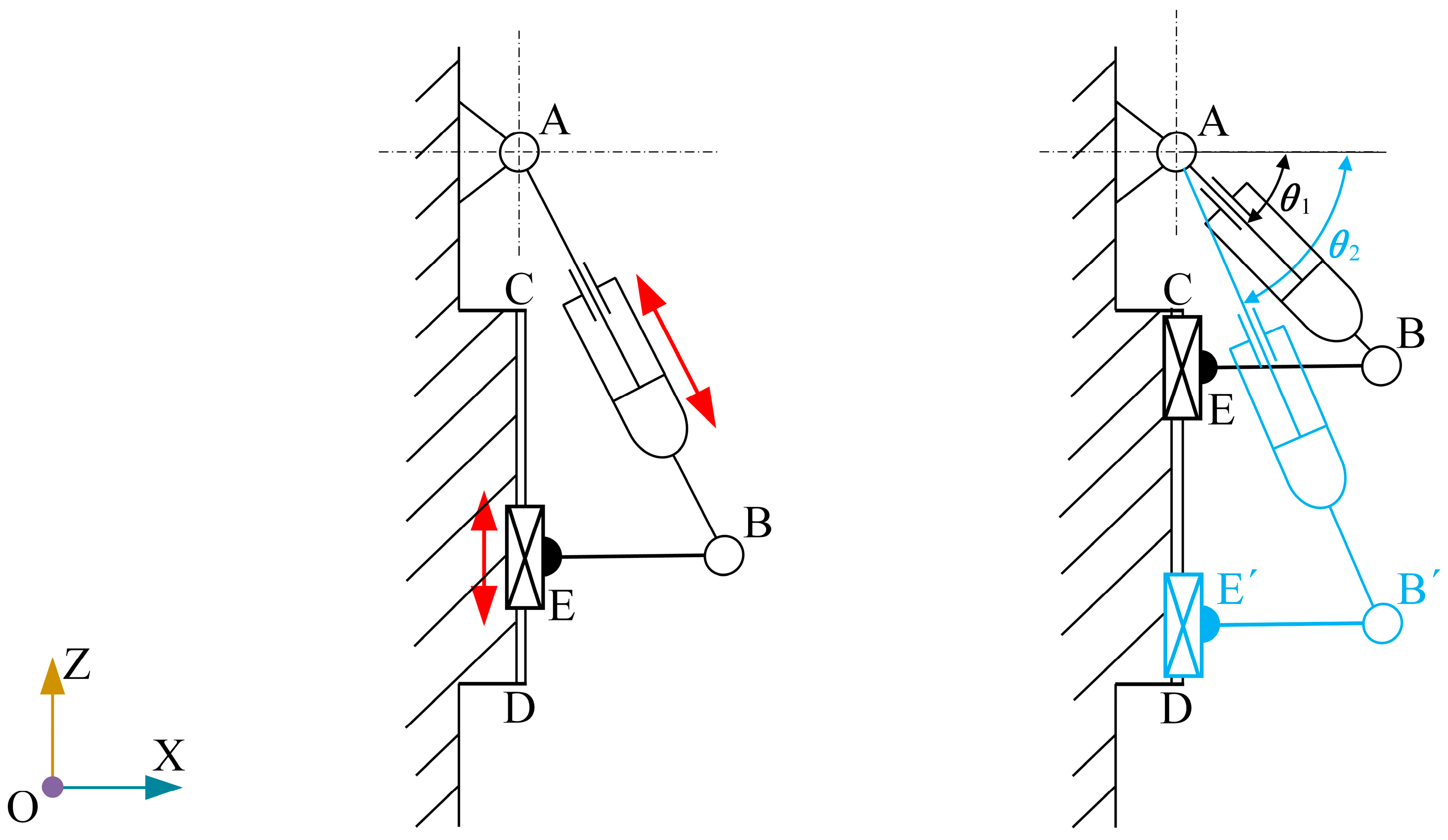
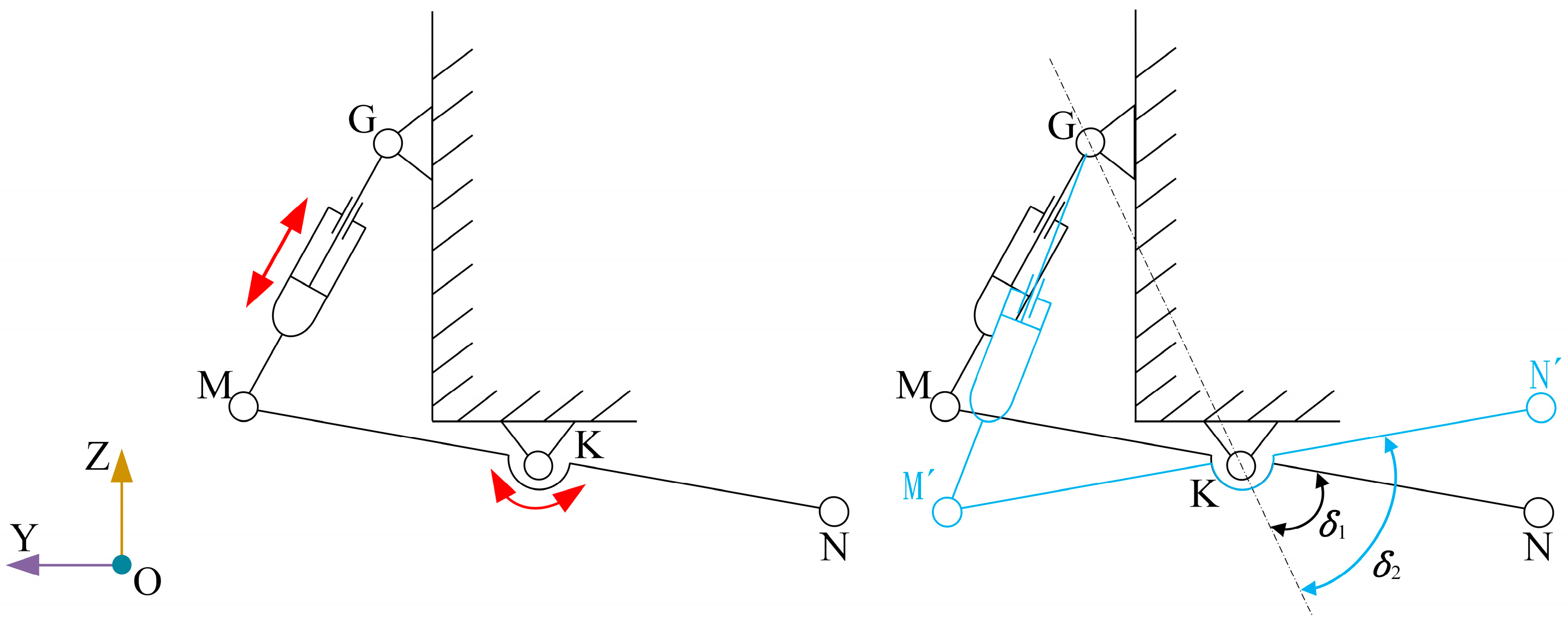
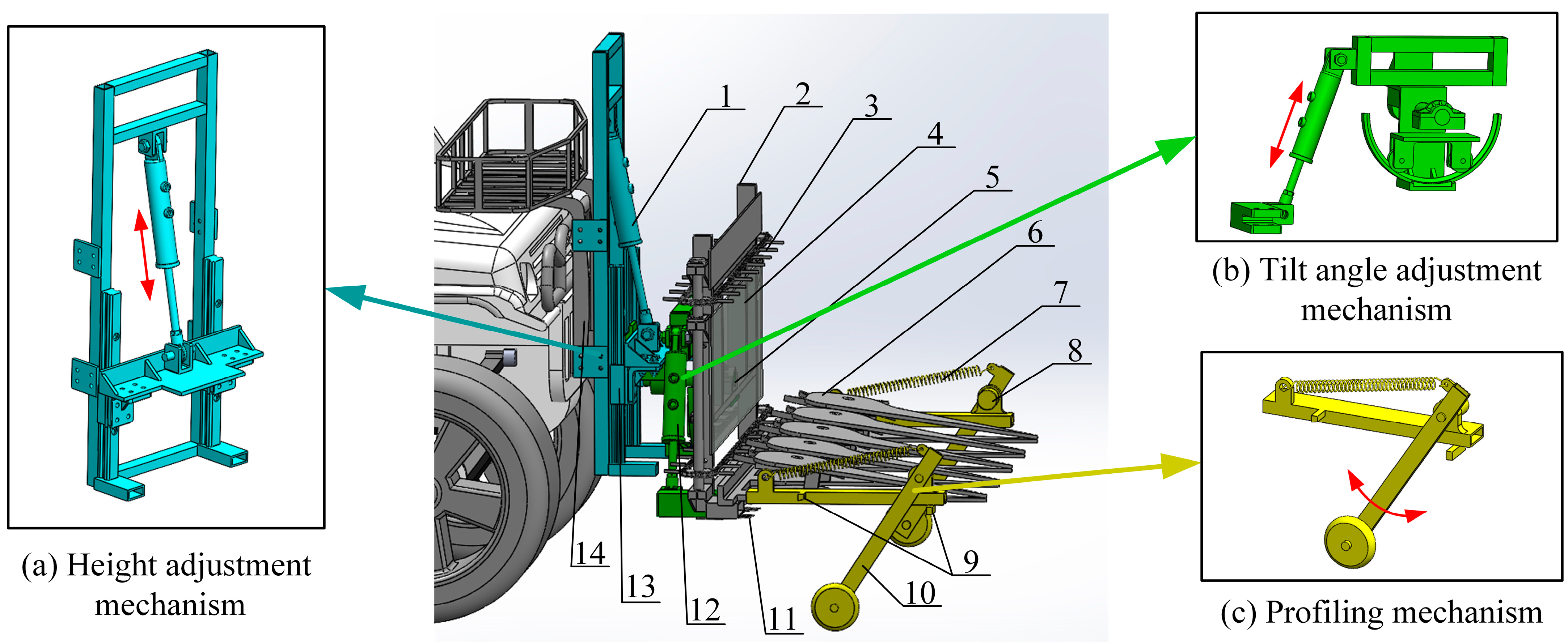
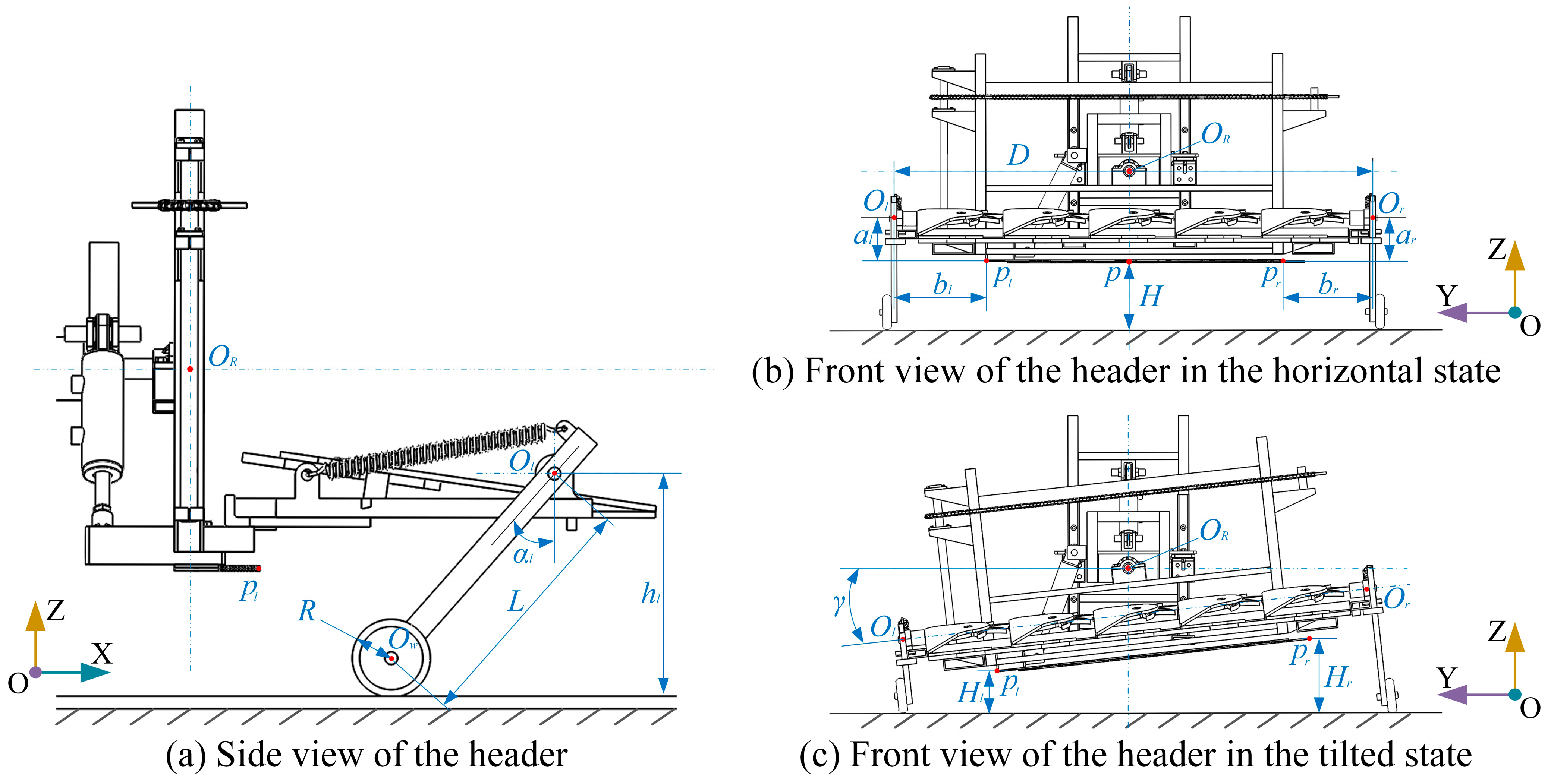





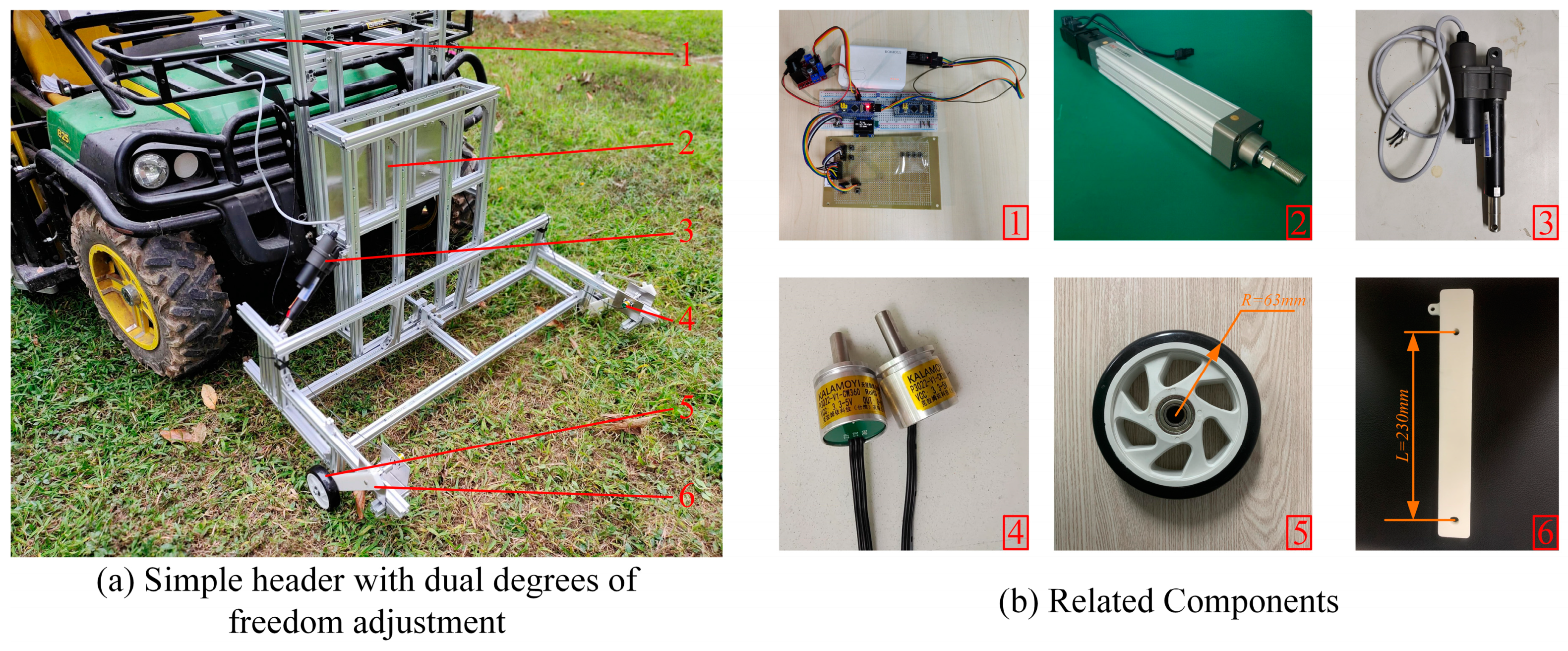

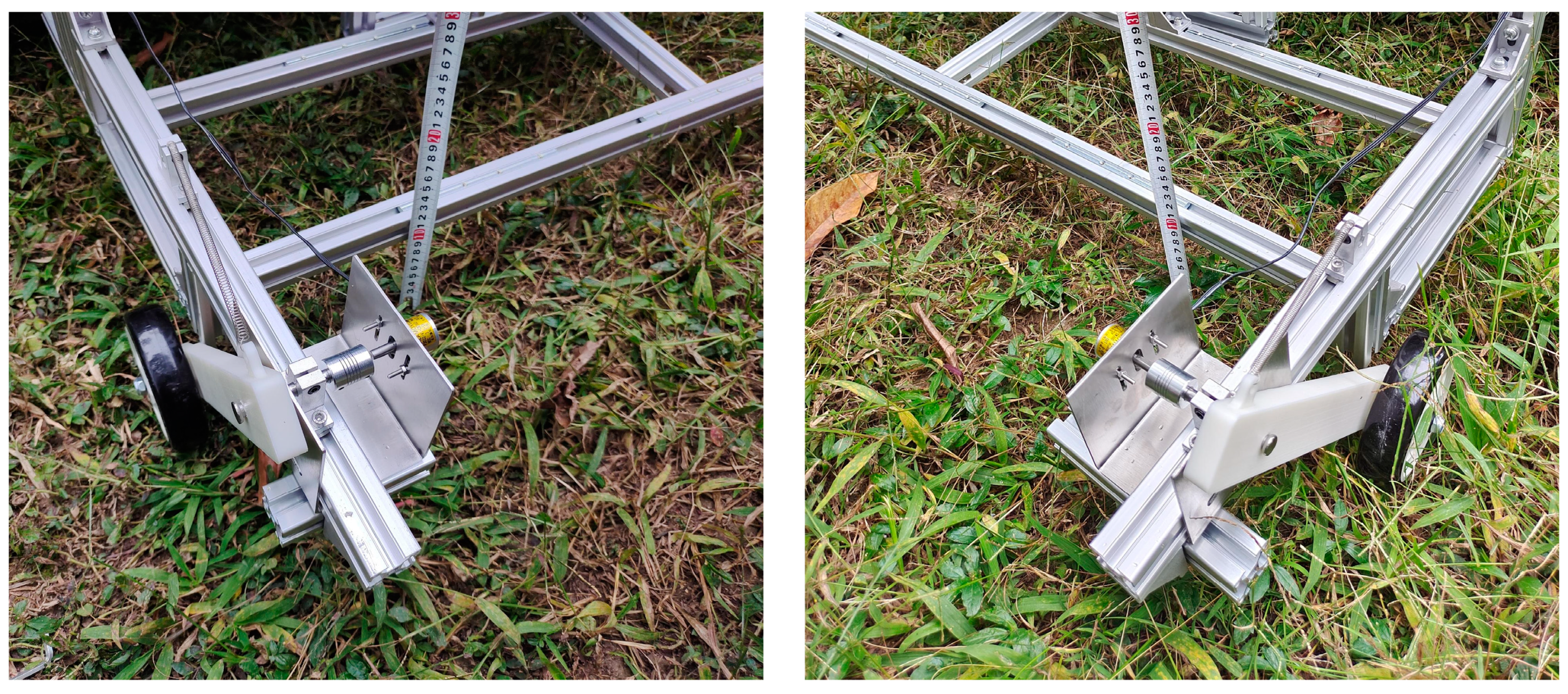

| Parameters | Value |
|---|---|
| Header width (mm) | 1200 |
| Header weight (kg) | 120 |
| Chopper type | Reciprocating type |
| Height hydraulic cylinder stroke (mm) | 300 |
| Tilt hydraulic cylinder stroke (mm) | 220 |
| Header tilt adjustment range (°) | ±20 |
| Maximum rotation angle of the contour rod (°) | 83 |
| NB | NM | NS | ZO | PS | PM | PB | ||
|---|---|---|---|---|---|---|---|---|
| NB | PB/NB/PS | PB/NB/NS | PM/NM/NB | PM/NM/NB | PS/NS/NB | ZO/ZO/NM | ZO/ZO/PS | |
| NM | PB/NB/PS | PB/NB/NS | PM/NM/NB | PS/NS/NM | PS/NS/NM | ZO/ZO/NS | NS/ZO/ZO | |
| NS | PM/NB/ZO | PM/NM/NS | PM/NS/NM | PS/NS/NM | ZO/ZO/NS | NS/PS/NS | NS/PS/ZO | |
| ZO | PM/NM/ZO | PM/NM/NS | PS/NS/NS | ZO/ZO/NS | NS/PS/NS | NM/PM/NS | NM/PM/ZO | |
| PS | PS/NM/ZO | PS/NS/ZO | ZO/ZO/ZO | NS/PS/ZO | NM/PS/ZO | NM/PM/ZO | NM/PB/ZO | |
| PM | PS/ZO/PB | ZO/ZO/NS | NS/PS/PS | NM/PS/PS | NM/PM/PS | NM/PB/PS | NB/PB/PB | |
| PB | ZO/ZO/PB | ZO/ZO/PM | NM/PS/PM | NM/PM/PM | NB/PM/PS | NB/PB/PS | NB/PB/PB | |
| Test | Calculated Height (mm) | Measured Height (mm) | Absolute Error (mm) | Relative Error | ||||
|---|---|---|---|---|---|---|---|---|
| 1 | 211.7 | 214.8 | 209 | 212 | −2.7 | −2.8 | 1.25% | 1.31% |
| 2 | 183.0 | 186.7 | 179 | 182 | −4.0 | −4.7 | 2.18% | 2.52% |
| 3 | 136.1 | 163.6 | 131 | 161 | −5.1 | −2.6 | 3.75% | 1.57% |
| 4 | 199.5 | 187.9 | 196 | 193 | −3.5 | 5.1 | 1.78% | 2.70% |
| 5 | 197.7 | 198.0 | 192 | 195 | −5.7 | −3.0 | 2.87% | 1.52% |
| 6 | 160.4 | 185.6 | 158 | 182 | −2.4 | −3.6 | 1.52% | 1.92% |
| 7 | 169.4 | 176.1 | 172 | 173 | 2.6 | −3.1 | 1.53% | 1.78% |
| 8 | 153.7 | 154.9 | 156 | 158 | 2.3 | 3.1 | 1.52% | 2.01% |
| 9 | 145.0 | 150.7 | 142 | 147 | −3.0 | −3.7 | 2.04% | 2.49% |
| 10 | 127.7 | 133.8 | 125 | 131 | −2.7 | −2.8 | 2.13% | 2.08% |
| 11 | 123.5 | 121.3 | 126 | 124 | 2.5 | 2.7 | 2.06% | 2.22% |
| 12 | 117.4 | 120.0 | 121 | 121 | 3.6 | 1.0 | 3.10% | 0.87% |
| 13 | 120.9 | 127.6 | 119 | 129 | −1.9 | 1.4 | 1.57% | 1.07% |
| 14 | 102.8 | 103.5 | 107 | 108 | 4.2 | 4.5 | 4.10% | 4.32% |
| 15 | 157.8 | 164.6 | 162 | 166 | 4.2 | 1.4 | 2.68% | 0.85% |
| 16 | 171.9 | 163.0 | 169 | 164 | −2.9 | 1.0 | 1.68% | 0.62% |
| 17 | 180.4 | 184.3 | 183 | 188 | 2.6 | 3.7 | 1.47% | 1.99% |
| 18 | 163.1 | 163.1 | 159 | 166 | −4.1 | 2.9 | 2.54% | 1.76% |
| 19 | 157.0 | 157.5 | 161 | 158 | 4.0 | 0.5 | 2.54% | 0.34% |
| 20 | 159.7 | 163.2 | 164 | 159 | 4.3 | −4.2 | 2.68% | 2.60% |
| Test | Target Value | Measurement Value | Error Value | |||||
|---|---|---|---|---|---|---|---|---|
| (mm) | (°) | (mm) | (mm) | (°) | (mm) | (mm) | (°) | |
| 1 | 150 | 0 | 0 | 148.0 | −0.57 | −12 | −2.0 | −0.57 |
| 2 | 150 | 0 | 0 | 153.0 | 0.57 | 12 | 3.0 | 0.57 |
| 3 | 150 | 0 | 0 | 157.0 | 0.48 | 10 | 7.0 | 0.48 |
| 4 | 150 | 0 | 0 | 155.5 | 0.24 | 5 | 5.5 | 0.24 |
| 5 | 150 | 0 | 0 | 146.0 | −0.57 | −12 | −4.0 | −0.57 |
| 6 | 150 | 0 | 0 | 143.5 | −0.14 | −3 | −6.5 | −0.14 |
| 7 | 150 | 0 | 0 | 155.5 | −0.14 | −3 | 5.5 | −0.14 |
| 8 | 150 | 0 | 0 | 142.5 | −0.43 | −9 | −7.5 | −0.43 |
| 9 | 150 | 0 | 0 | 144.5 | −0.14 | −3 | −5.5 | −0.14 |
| 10 | 150 | 0 | 0 | 155.0 | 0.19 | 4 | 5.0 | 0.19 |
| 11 | 150 | 0 | 0 | 153.5 | 0.43 | 9 | 3.5 | 0.43 |
| 12 | 150 | 0 | 0 | 145.0 | 0.57 | 12 | −5.0 | 0.57 |
| 13 | 150 | 0 | 0 | 154.5 | 0.05 | 1 | 4.5 | 0.05 |
| 14 | 150 | 0 | 0 | 143.5 | −0.24 | −5 | −6.5 | −0.24 |
Disclaimer/Publisher’s Note: The statements, opinions and data contained in all publications are solely those of the individual author(s) and contributor(s) and not of MDPI and/or the editor(s). MDPI and/or the editor(s) disclaim responsibility for any injury to people or property resulting from any ideas, methods, instructions or products referred to in the content. |
© 2024 by the authors. Licensee MDPI, Basel, Switzerland. This article is an open access article distributed under the terms and conditions of the Creative Commons Attribution (CC BY) license (https://creativecommons.org/licenses/by/4.0/).
Share and Cite
Luo, Y.; Liao, Z.; Shi, S.; Dai, J.; Yuan, K.; Zhao, J.; Li, Y.; Zhao, Z. Design and Testing of a 2-DOF Adaptive Profiling Header for Forage Harvesters. Agronomy 2024, 14, 1909. https://doi.org/10.3390/agronomy14091909
Luo Y, Liao Z, Shi S, Dai J, Yuan K, Zhao J, Li Y, Zhao Z. Design and Testing of a 2-DOF Adaptive Profiling Header for Forage Harvesters. Agronomy. 2024; 14(9):1909. https://doi.org/10.3390/agronomy14091909
Chicago/Turabian StyleLuo, Yangfan, Zhihui Liao, Shenye Shi, Jiuxiang Dai, Kai Yuan, Jingxing Zhao, Yuanhong Li, and Zuoxi Zhao. 2024. "Design and Testing of a 2-DOF Adaptive Profiling Header for Forage Harvesters" Agronomy 14, no. 9: 1909. https://doi.org/10.3390/agronomy14091909






